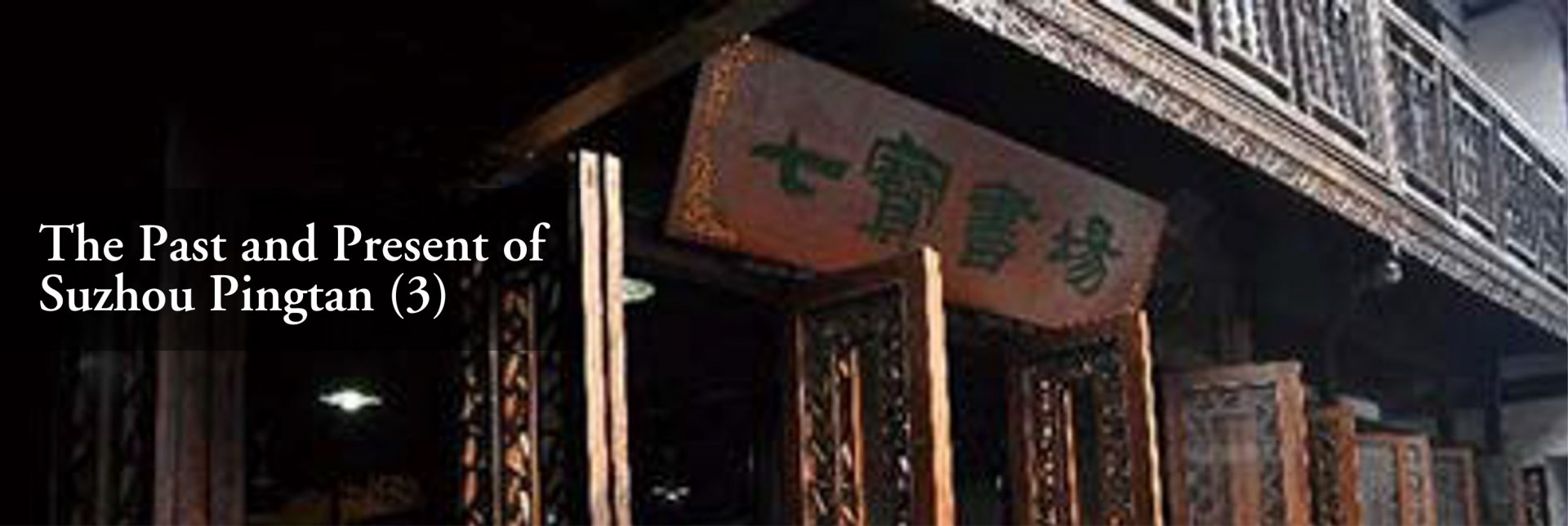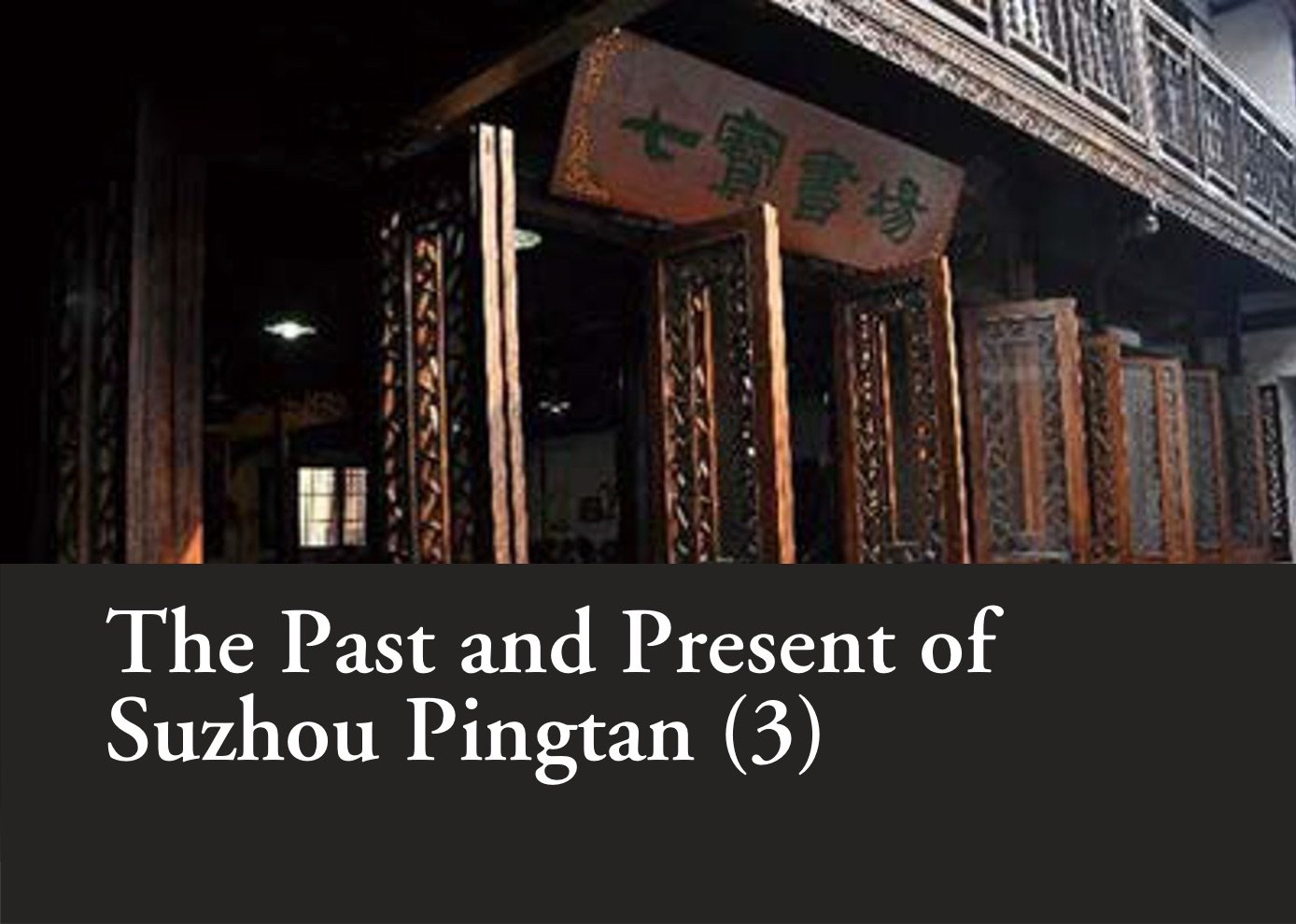The Past and Present of Suzhou Pingtan (3): Suzhou Pingtan, Flying One’s Own Colours
What is the essence of Suzhou pingtan that has been formed over the course of 400 years? Or what is pingtan in essence? The biggest difference between pingtan and traditional opera lies in the fact that the former is a way of expressing mainly through speaking while the latter is a way of expressing via acting. In traditional opera, actors play a specific role on stage, and when they play Guan Gong (关公, a general in the period of the Three Kingdoms), they must have a red face, wear green robe, and hold a green dragon broadsword. But pingtan is different. Pingtan artists don’t need to wear makeup or costume. They just wear a long gown and can present a vivid and powerful image of Guan Gong to you on stage through words. They use their mouths and tongues to display the scene of war, to stimulate you to see colorful historical scenes with your own imagination. Here is a story. Xie Jin (谢晋, 1923-2008) once wanted to direct a movie about the history of the Three Kingdoms (三国时期, 220-280). He invited my father Tang Gengliang to be his consultant. He told my father that the storytelling can bring the grand scene of the Battle of Red Cliff (赤壁之战, in the year of 208) to life, however, film cannot achieve the same effect due to its realistic feature. This is the difference between pingtan and traditional opera. Pingtan focuses on speaking, supplemented by joking, music playing, and singing. In the past, it was said that “thousands of pounds of words” were needed to tell a good story while “four ounces of singing” were needed. That explains the difficulty of speaking in the storytelling.
The second difference is that one storyteller plays different roles through jumping in and out of the story. He can speak on behalf of one character, and then he will jump out of the story to continue his role as a storyteller. Then, he will enter the story again but speak as another person. Therefore, he just stands there, but he acts different characters. He also needs to analyze the character’s psychological state and make comments as a storyteller. In this way, we can say that it is impossible for other traditional Chinese operas to achieve this. The acting of storytelling is limited to hand movements only, so it is an auxiliary form of speaking and cannot be equal to the acting of operas.
When we discussed the relationship between pingtan and the geographical environment of Jiangnan in the first part, we learned about the development of Suzhou pingtan, which is performed in the story houses along the docks. Performing in a large theater is definitely not the commonplace for pingtan.
Suzhou pingtan stands out in the garden of quyi and operas thanks to these artistic characteristics, becoming the orchid of quyi and widely popular. The audience of pingtan is comprised of people from all walks of life, no matter labouring people or intellectuals. The late Professor Guo Shaoyu (郭绍虞, 1893-1984), an expert in the history of Chinese literary criticism, listened to the pingtan programs of the Shanghai Radio every night. He said that listening to pingtan has become an indispensable part of his daily life. He specially wrote a poem and sent it to the radio station to congratulate the holding of the pingtan radio conference. The late scholar studying the inscriptions on ancient bronzes and stone tablets Chen Julai (陈巨来, 1904-1984), the famous film actress Shangguan Yunzhu (上官云珠, 1920-1968), and the famous Peking Opera artists Zhou Xinfang (周信芳, 1895-1975) and Gai Jiaotian (盖叫天, 1888-1971) were all passionate listeners of the pingtan programs.
Why are the Peking opera artists like Zhou and Gai interested in pingtan? The reason is that they regard pingtan as a valuable source of nourishment for their own performances. Zhou Xinfang once said to Wang Yunfeng (汪云峰, 1895-1957), the pingtan master who excelled in the story of The Legend of the Golden Spear (Jin qiang zhuan金枪传), that he admired pingtan artists because the Old General Yang (杨业, 932-986) performed by Wang without makeup was more real and vivid than his performance with makeup. Zhou also had high praise for the storytelling skills of the pingtan masters like Yan Xuetin, Jiang Yuequan, Liu Tianyun, Tang Gengliang and Zhang Hongsheng. He believed that it was not easy for pingtan artists to attract the audience’s attention, relying solely on the art of speaking and singing. The art of pingtan emphasizes “speaking (说), joking (噱), music playing (弹), and singing (唱)”, with “speaking” taking the first place. The speaking in Peking Opera is also difficult and important, but not as difficult or important as the speaking in pingtan.

In the early 1960s, when Yang Zhenxiong (杨振雄, 1920-1998) performed Wu Song, one of the characters from the Water Margin, Gai Jiaotian went to every performance for two months. He said that, “I played Wu Song from fighting the tiger to fighting in the inn run by Sun Erniang, all in one night, however, it would take Zhenxiong a month or two to tell the story. I was really curious and wanted to know how he could tell such a story for such a long time. After hearing it, I know it’s reasonable. I’m addicted to the delicate presentation of the story.”
The famous Kunqu artist Yu Zhenfei (俞振飞, 1902-1993) also commented on pingtan. In 1948, he listened to the storytelling of The Palace of Eternal Youth (Changsheng dian长生殿) performed by Yang Zhenxiong with great interest. Its original Kunqu Opera has more than 50 scenes, and it is said that it would take seven or eight nights to perform it. I don’t have the chance to watch the whole version because some of the scenes are interludes without storylines, so actors are not willing to perform and audiences are not willing to watch. After years of performing practice, half of them are gradually eliminated. Now there are only 25 scenes left on the opera stage. However, the pingtan of the whole play would last for five months with 45 minutes a day. I listened to it from the beginning to the end and was attracted deeply by the storylines and the portrayal of the characters. The portrayal of Emperor Minghuang (唐玄宗, 685-762)’s inner world is very inspiring for my performance.
These opera masters love to listen to pingtan because they are determined to learn the unique artistic characteristics of pingtan that traditional Chinese operas do not have. In the real life, there are stories showing that a theatrical troupe is no match for a pingtan artist. In the summer of 1942, Yan Xueting (严雪亭, 1913-1983), known as the “Emperor of Pingtan”, came to Changshu for a performance, causing a sensation throughout the county. The cinema near the story house even closed for several days. In 1945, when he performed in Pinghu, Zhejiang Province, the audience came either on foot or by boat from the nearby towns, making the inns and restaurants around overcrowded. The Yamei Theater in the same town had to cancel their programs for the lack of the audience and in the end, the members of the troupe also went to the story house for pingtan performance. It can be clearly seen that operas cannot compete with pingtan.
Suzhou pingtan has played a significant role in the integration of Jiangnan culture due to its wide circulation. Pingtan is an art not only for ordinary people, but also for elites, catering for both general and elegant tastes. Therefore, when pingtan spreads along the water network in Jiangnan, it actually gives Jiangnan a culture of both elegant and vulgar. Pingtan gives the elite a channel to understand the general public, and the general public a channel to get the information from the elite, which makes Jiangnan a rational place overall. The manifestation of this rationality in Jiangnan society is obvious. For example, in history, the Jiangnan region bore heavy taxes from the country. Suzhou’s land only accounted for one ninety-ninth of the country’s arable land, however, in the Qing Dynasty, it bore one tenth of the country’s taxes. The burden on the people of Suzhou was heavy, but they had never risen in revolt. Suzhou people were smart, so they knew it was useless to do so. Instead, they worked meticulously in agriculture, vigorously developed sidelines by growing cotton, raising silkworms, and developed commerce. In this rational way, Suzhou people have been living a better life than other places.
Since modern times, many social elites have regarded pingtan as an important means of promoting and implementing “popular education”. During 1912-1949, intellectuals gave high praise to Suzhou pingtan in the Shanghai newspaper Shun Pao (申报). They thought that Suzhou pingtan had the same value as Homer’s epic in that it told historical stories to educate the people. This is also why many cultural figures, as I mentioned in the second part, like pingtan. The interaction of cultural figures and pingtan artists has enabled pingtan to spread good values and aesthetic views to the public. Therefore, pingtan is the organic combination of elite culture and civilian culture, reflecting the cultural structure of Jiangnan society, and is enjoyed by Jiangnan people.
Looking at the past and present of Suzhou pingtan, we should maintain and promote its artistic characteristics and essence, highlight its strengths, and innovate on the basis of inheriting traditional stories. It’s of vital importance to maintain the flesh and blood connection between pingtan and the audience in Jiangnan and to keep the market in Jiangnan via going among docks and entering story houses. This is what Chen Yun (陈云, 1905-1995), politician and founder of Chinese economic construction, called “taking the right path (走正路)”.
All articles/videos are prohibited from reproducing without the permission of the copyright holder.




Welcome to leave a message:
Please Sign In/Sign Up as a member and leave a message